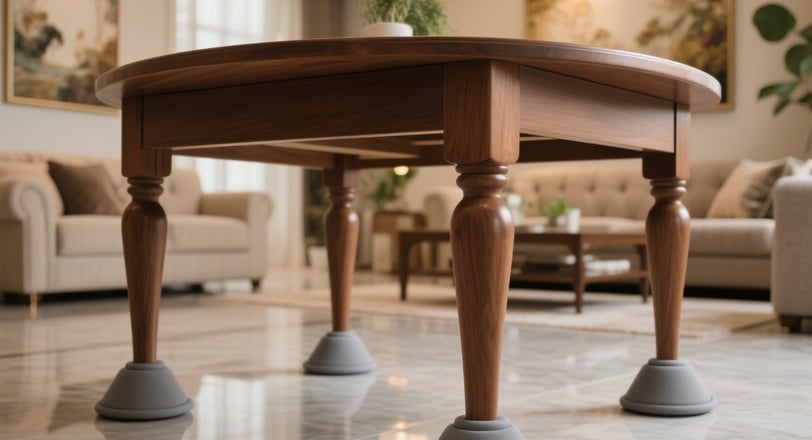Fuzhou Victor Furniture Co., Ltd.
Furniture Wooden Leg Non-Slip Pads: Your Essential Home Solution
6/9/20257 min read


Introduction to Non-Slip Pads
Non-slip pads, particularly those designed for wooden furniture legs, have emerged as vital accessories in modern households. These small yet significant items are crafted from various materials and can be easily affixed to the base of furniture legs to enhance stability and protection. Non-slip pads serve a crucial purpose: they prevent furniture from sliding across the floor, which can lead to a range of common household issues, including shifting furniture, unsightly floor scratches, and disruptive noise during movement.
One of the predominant challenges in any living space is the tendency of heavy furniture pieces, such as tables, chairs, and sofas, to shift when in use. This movement not only poses a minor inconvenience but can also result in significant damage to both the furniture and flooring. Wooden floors, in particular, are prone to scratches and dents caused by the friction between furniture and the surface below. The application of non-slip pads not only helps to secure the furniture in place but also acts as a protective barrier, minimizing direct contact with the floor and thereby reducing the risk of damage.
Moreover, noise generated by moving furniture can be a considerable distraction, particularly in quiet environments. Furniture wooden leg non-slip pads address this issue by cushioning the contact points between the furniture and floor, thus muffling sounds. As homeowners increasingly seek solutions to prevent these everyday problems, non-slip pads have gained popularity in various settings, from residential homes to offices. Their role as an essential home solution cannot be overstated, making them a preferred choice for anyone looking to maintain both the aesthetic and functional integrity of their living spaces.
How Non-Slip Pads Protect Your Floors
Non-slip pads act as a crucial barrier between furniture legs and various types of flooring, significantly enhancing floor protection. Different flooring materials, such as hardwood, laminate, tile, and vinyl, each present unique challenges when it comes to susceptibility to damage from furniture movement. Understanding these vulnerabilities underscores the importance of using non-slip pads to maintain the integrity and visual appeal of your floors.
Hardwood floors are particularly vulnerable to scratches and dents arising from the shifting of heavy furniture. Even small movements can leave unsightly marks, adversely affecting the finish and durability of the wood. Non-slip pads provide a cushion that minimizes contact friction, effectively distributing weight and mitigating damage.
Similarly, laminate flooring may also suffer when furniture is dragged or moved without any protective measures in place. The outer layer of laminate can easily get scratched or even gouged, leading to costly repairs or replacements. By utilizing non-slip pads, homeowners can prevent such mishaps, ensuring the laminate's protective coating remains intact for a longer period.
Tile floors, while generally more resilient than hardwood and laminate, are still not impervious to the effects of furniture movement. Heavy items can chip or crack tiles if shifted carelessly. Non-slip pads not only enhance grip but also prevent such incidents from occurring, thereby safeguarding the tiles from potential breakage.
Vinyl flooring, often chosen for its aesthetic appeal and durability, can also face challenges with furniture placement. As with the other flooring types, the application of non-slip pads can help preserve vinyl by preventing abrasions and scratches, maintaining its visual charm over time.
By implementing non-slip pads, homeowners can effectively protect all types of floors from the damaging effects of furniture movement, ultimately prolonging their lifespan and maintaining their appearance.
Enhancing Stability and Safety
Ensuring the stability and safety of furniture is a critical aspect of home design and functionality, particularly in households with young children or elderly individuals. Furniture wooden leg non-slip pads serve as an effective solution for this concern, significantly enhancing the stability of various furniture pieces. By providing a secure grip to the floor, these pads reduce the likelihood of furniture sliding or tipping over, which can lead to accidents and injuries.
The primary role of non-slip pads is to create friction between the furniture legs and the floor surface, thereby minimizing any unwanted movement. This is especially important in high-traffic areas where furniture may be subjected to frequent contact. In homes where children play or older adults navigate, the risk of slips and falls becomes a pressing hazard. By incorporating non-slip pads onto furniture legs, homeowners can create a safer environment, reducing the chances of such incidents.
In addition to preventing movement, non-slip pads also protect flooring surfaces from scratches and dents, which often result from furniture sliding around. The pads act as a buffer, absorbing impact and minimizing wear on both carpets and hard floors. This dual functionality of enhancing stability while also preserving flooring integrity makes non-slip pads an essential accessory for any home.
Furthermore, the installation of these pads is straightforward and requires minimal effort. Most non-slip pads are designed for easy attachment, allowing individuals to upgrade their furniture with little hassle. This simple enhancement not only boosts safety but also contributes to long-term maintenance of the furniture itself. Ultimately, the use of furniture wooden leg non-slip pads is a proactive step toward creating a safer living space for all occupants in the home.
Reducing Noise: A Quieter Home Experience
In an environment where comfort and tranquility are essential, the presence of unwanted noise can significantly detract from the overall living experience. Moving furniture, though necessary for various activities such as cleaning or redecorating, often generates sound that can be disruptive. One effective solution to this issue is the implementation of furniture wooden leg non-slip pads. These pads not only provide stability and prevent slipping but also play a crucial role in sound absorption.
Non-slip pads are typically crafted from materials known for their sound-dampening properties, such as rubber, felt, and silicone. Rubber pads offer excellent grip and can absorb shock, which helps minimize the noise created when heavy furniture is moved across various flooring surfaces. Felt pads, on the other hand, are particularly adept at muffling sound. They create a smooth barrier between furniture and floors, softening the impact and thus mitigating noise levels significantly. This feature can be especially beneficial in homes with wooden or tiled flooring, where the echoing of furniture movement can be quite pronounced.
The installation of wooden leg non-slip pads is a straightforward process that can lead to remarkable benefits. By adhering these pads to the base of furniture legs, homeowners can effectively reduce the noise created during routine activities like rearranging furniture or simply shifting a chair. Over time, this simple addition not only enhances the aesthetics but also contributes to a more peaceful environment. As comfort remains a priority, reducing noise through such home solutions is becoming increasingly valuable for those looking to improve their living spaces.
Choosing the Right Non-Slip Pads for Your Furniture
When it comes to selecting the appropriate non-slip pads for your furniture, several key considerations come into play that can significantly impact both functionality and aesthetics. The two primary factors to consider are the type of material used in the non-slip pads and the corresponding flooring type in your home.
Non-slip pads can be made from various materials, including rubber, felt, and silicone. Rubber non-slip pads are particularly effective for preventing movement on hard surfaces, such as tile or hardwood, as they provide excellent grip. Alternatively, felt pads are advantageous for protecting flooring from scratches while offering decent slip resistance on softer surfaces like carpets. Silicone pads offer versatility due to their strong grip and durability, making them suitable for a range of furniture and flooring types.
The size and thickness of the non-slip pads are also crucial elements in ensuring optimal performance. The pad should be large enough to cover the furniture leg's surface area adequately, allowing for an even distribution of weight without compromising stability. Conversely, excessively thick pads may create an unsightly gap between the furniture leg and the floor, while overly thin pads might not provide sufficient grip.
Design and shape should not be overlooked, particularly with regard to the furniture style. Non-slip pads are available in various shapes, such as square, round, or custom-cut, making it possible to select options that align seamlessly with your furniture’s aesthetic. Additionally, opting for pads that blend with the color of your furniture can enhance visual appeal while serving their intended purpose.
Ultimately, by carefully assessing these factors, you can choose the right non-slip pads tailored to your specific needs and the unique characteristics of your home’s furnishings and flooring. This thoughtful selection process will help mitigate furniture movement while preserving the integrity of your flooring surfaces.
Installation Tips and Best Practices
Installing non-slip pads on furniture legs is a straightforward task that can significantly enhance stability and protect your flooring. Proper preparation is crucial before initiating the installation process. Begin by cleaning the surfaces of the furniture legs to remove any dust or grease, ensuring the adhesive on the non-slip pads adheres effectively. A clean surface promotes better longevity and performance of the pads.
Next, measuring your furniture legs accurately is essential to achieve a secure fit. Use a measuring tape to obtain dimensions of each leg, considering the diameter for round legs or the width and length for square or rectangular legs. Once you have these measurements, you can select the appropriate sized non-slip pads or cut larger pads accordingly. A sharp pair of scissors or a utility knife could be used to trim the pads to your desired size. For best results, always cut gradually, checking the fit against the furniture leg frequently to avoid undersizing.
After cutting the pads, peel off the adhesive backing and firmly press them onto the furniture legs using even pressure. This will help eliminate any air bubbles and ensure strong adhesion. It's advisable to allow the adhesive to cure for a few hours before moving the furniture around. Routine inspection of the non-slip pads is also essential, as wear and tear can occur over time. Regularly check their condition and replace them if you notice signs of deterioration, such as peeling or a loss of grip. Incorporating these best practices will help maintain the effectiveness of non-slip pads, thereby ensuring that your furniture remains stable and your flooring is well-protected.
Conclusion
In conclusion, the implementation of furniture wooden leg non-slip pads represents an invaluable enhancement in home maintenance practices. These discreet yet highly functional accessories serve multiple purposes that markedly improve both safety and aesthetics within living spaces. By placing non-slip pads on furniture legs, homeowners can effectively guard their flooring against scratches, dents, and other damage. This preventative measure not only contributes to the longevity of floors—whether they are hardwood, laminate, or tile—but also reduces the need for costly repairs and refinishing.
Furthermore, non-slip pads inherently offer a significant boost in safety within the home. The added friction they provide minimizes the risk of slips and falls, especially in areas where furniture may inadvertently slide. This feature is particularly beneficial in households with children or elderly individuals, where stability becomes paramount. The peace of mind achieved through enhanced safety cannot be overstated, ensuring that each space is conducive to comfortable living.
Moreover, the aesthetic appeal of a home can also be enhanced through the use of these pads. By offering a clean and polished look at the base of furniture, non-slip pads contribute to a more cohesive décor. Available in various styles and materials, they can easily blend with existing interior design schemes, subtly accentuating the beauty of the furniture while maintaining functionality.
Investing in furniture wooden leg non-slip pads is not merely a matter of convenience; it is a strategic move towards maintaining and improving the overall living environment. As such, it is advisable for homeowners to consider this simple yet impactful solution for their homes, thus enhancing safety and preserving valuable flooring for years to come.
